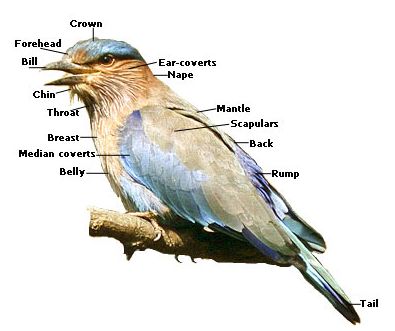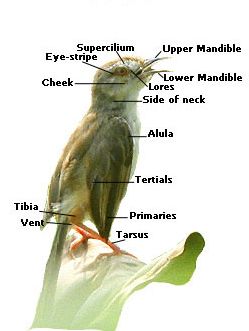| |
ENVIS Technical Report: 43, February 2012 |
 |
ECOLOGICAL STATUS OF DANDELI ANSHI TIGER RESERVE |
 |
Energy and Wetlands Research Group, Centre for Ecological Sciences,
Indian Institute of Science, Bangalore – 560012, India.
*Corresponding author: cestvr@ces.iisc.ac.in
|
|
BIRDS
Birds are one of the most widely studied and the best biological indicators because they are easy to indentify, compared to many of the other class of organisms and virtually inhabit all the kinds of habitat. Because of their omnipresence, the attractive colour and the characteristic vocal calls, they have attracted many of the scientist and amateurs in field of ornithology and today the best of the field guides are available for identifying birds.
 
Fig.5 : Body parts of Birds
Image Source: http://www.kolkatabirds.com/topography.htm
Anshi Dandeli Tiger Reserve is known for its rich bird diversity 197 species of birds have been recorded from the Anshi National Park (Uttangi, year 1994). The reserve has good population of four types of Hornbills- Common Grey Hornbill, Malabar Grey Hornbill, Great pied hornbill (NT*) and Malabar Pied hornbill (NT*).
The sampling protocol for bird involves walking along a transect route for a fixed time (1 hr) keeping the pace of walking as uniform as possible. The survey must begin in early morning as soon as sufficient light is available for identification of birds. The observer should record all the species encountered on the way seen or heard. The transect should not be biased towards easily approachable routes and must cover different habitats available (open land, farm land, deciduous forest, semi evergreen patch, riparian vegetation etc. It is important to make a rough sketch of the unidentified birds for later identification.
The list of birds observed during the workshop is given in table 6.
Table 5: Data sheet for bird survey
| Data Sheet No: |
| Name of the Observers: |
Date
Start time: End time:
Start Lat. Long. Alt.
End Lat. Long. Alt.
Beet : Range: Nearest village:
Habitat: Deciduous forest/Plantation/ Farm land/ Grass land/ Barren land/ Water body |
| Sr. no. |
Name of the bird |
Frequency |
Special remarks
(if any) |
| |
|
|
|
| |
|
|
|
| |
|
|
|
| |
|
|
|
| |
|
|
|
| |
|
|
|
| |
|
|
|
| |
|
|
|
| |
|
|
|
| |
|
|
|
| |
|
|
|
| |
|
|
|
Table 6: Birds in and round Kulgi Nature camp and Nagazari valley
| Sr.No. |
Name |
Scientific name |
| 1 |
Ashy Drongo |
Dicrurus leucophaeus |
| 2 |
Asian brown Flycatcher |
Muscicapa dauurica |
| 3 |
Asian Paradise Flycatcher |
Terpsiphone paradisi |
| 4 |
Bar-winged Flycatcher-Shrike |
Hemipus picatus |
| 5 |
Black Drongo |
Dicrurus macrocercus |
| 6 |
Black headed Oriole |
Oriolus xanthornus |
| 7 |
Black lored Tit |
Parus xanthogenys |
| 8 |
Black Throated Munia |
Lonchura kelaarti |
| 9 |
Black-naped Monarch |
Hypothymis azurea |
| 10 |
Blyth's reed Warbler |
Acrocephalus dumetorum |
| 11 |
Brahminy Kite |
Haliastur indus |
| 12 |
Brown headed Barbet |
Megalaima zeylanica |
| 13 |
Brown Shrike |
Lanius cristatus |
| 14 |
Chestnut tailed starling |
Sturnus malabaricus |
| 15 |
Common Flameback |
Dinopium javanense |
| 16 |
Common Iora |
Aegithina tiphia |
| 17 |
Common Rosefinch |
Carpodacus erythrinus |
| 18 |
Common Sandpiper |
Actitis hypoleucos |
| 19 |
Common Wood shrike |
Tephrodornis pondicerianus |
| 20 |
Crested Serpent Eagle |
Spilornis cheela |
| 21 |
Crested tree Swift |
Hemiprocne coronata |
| 22 |
Crimson Fronted Barbet |
Megalaima rubricapilla |
| 23 |
Emerald Dove |
Chalcophaps indica |
| 24 |
Golden- fronted Chloropsis |
Chloropsis aurifrons |
| 25 |
Great Tit |
Parus major |
| 26 |
Greater Coucal |
Centropus sinensis |
| 27 |
Greater Racket Tailed Drongo |
Dicrurus paradiseus |
| 28 |
Greenish Warbler |
Phylloscopus trochiloides |
| 29 |
Grey-headed Fish-Eagle |
Ichthyophaga ichthyaetus |
| 30 |
House Crow |
Corvus splendens |
| 31 |
House Swift |
Apus affinis |
| 32 |
Indian Magpie Robin |
Copsychus saularis |
| 33 |
Indian Pond heron |
Ardeola grayii |
| 34 |
Jungle Crow |
Corvus macrorhynchos |
| 35 |
Jungle Fowl |
Gallus sonneratii |
| 36 |
Jungle Myna |
Acridotheres fuscus |
| 37 |
Lesser Adjutant |
Leptoptilos javanicus |
| 38 |
Lesser Flameback |
Dinopium benghalense |
| 39 |
Little Egret |
Egretta garzetta |
| 40 |
Malabar Grey Hornbill |
Ocyceros griseus |
| 41 |
Malabar Parakeet |
Psittacula columboides |
| 42 |
Malabar pied Hornbill |
Anthracoceros coronatus |
| 43 |
Malabar Whistling Thrush |
Myophonus horsfieldii |
| 44 |
Orange headed Thrush |
Zoothera citrina |
| 45 |
Oriental Magpie Robin |
Copsychus saularis |
| 46 |
plum-headed Parakeet |
Psittacula cyanocephala |
| 47 |
Pompadour Green Pigeon |
Treron pompadora |
| 48 |
Purple rumped Sunbird |
Leptocoma zeylonica |
| 49 |
Purple Sunbird |
Cinnyris asiaticus |
| 50 |
Brown Cheeked Fulvetta |
Alcippe poioicephala |
| 51 |
Red backed Shrike |
Lanius collurio |
| 52 |
Red throated Flycatcher |
Ficedula parva |
| 53 |
Red vented Bulbul |
Pycnonotus cafer |
| 54 |
Red whiskered Bulbul |
Pycnonotus jocosus |
| 55 |
Rufous Treepie |
Dendrocitta vagabunda |
| 56 |
Scarlet Minivet |
Pericrocotus flammeus |
| 57 |
Small Minivet |
Pericrocotus cinnamomeus |
| 58 |
Spotted Dove |
Streptopelia chinensis |
| 59 |
Stork billed Kingfisher |
Halcyon capensis |
| 60 |
Tailorbird |
Orthotomus sutorius |
| 61 |
Tickell's blue Flycatcher |
Cyornis tickelliae |
| 62 |
Tickell's Flowerpecker |
Dicaeum erythrorynchos |
| 63 |
Velvet fronted Nuthatches |
Sitta frontalis |
| 64 |
Verditer Flycatcher |
Eumyias thalassinus |
| 65 |
Vernal Hanging Parrot (lorikeet) |
Loriculus vernalis |
| 66 |
White breasted Waterhen |
Amaurornis phoenicurus |
| 67 |
White cheeked Barbet |
Megalaima viridis |
| 68 |
White rumped Munia |
Lonchura striata |
| 69 |
White rumped Shama |
Copsychus malabaricus |
| 70 |
White throated Kingfisher |
Halcyon smyrnensis |
| 71 |
Wire-tailed Swallow |
Hirundo smithii |
| 72 |
Yellow-footed Green Pigeon |
Treron phoenicopterus |
|
|
|
T.V. Ramachandra
Centre for Sustainable Technologies,
Centre for infrastructure, Sustainable Transportation and Urban Planning (CiSTUP),
Energy & Wetlands Research Group, Centre for Ecological Sciences, Indian Institute of Science, Bangalore – 560 012, INDIA.
E-mail : cestvr@ces.iisc.ac.in
Tel: 91-080-22933099/23600985,
Fax: 91-080-23601428/23600085
Web: http://ces.iisc.ac.in/energy
Subash Chandran M.DEnergy & Wetlands Research Group, Centre for Ecological Sciences, Indian Institute of Science, Bangalore – 560 012, INDIA.
E-mail:
mds@ces.iisc.ac.in
Rao G.R
Energy & Wetlands Research Group, Centre for Ecological Sciences, Indian Institute of Science, Bangalore – 560 012, INDIA.
E-mail:
grrao@ces.iisc.ac.in
Amit Yadav
Energy & Wetlands Research Group, Centre for Ecological Sciences, Indian Institute of Science, Bangalore – 560 012, INDIA.
Gururaja KV
Energy & Wetlands Research Group, Centre for Ecological Sciences, Indian Institute of Science, Bangalore – 560 012, INDIA.
E-mail:
gururaj@ces.iisc.ac.in
Karthick B
Energy & Wetlands Research Group, Centre for Ecological Sciences, Indian Institute of Science, Bangalore – 560 012, INDIA.
E-mail:
karthick@ces.iisc.ac.in
Uttam Kumar
Energy & Wetlands Research Group, Centre for Ecological Sciences, Indian Institute of Science, Bangalore – 560 012, INDIA.
E-mail:
uttam@ces.iisc.ac.in
Durga Madhab Mahapatra
Energy & Wetlands Research Group, Centre for Ecological Sciences, Indian Institute of Science, Bangalore – 560 012, INDIA.
E-mail:
durgamadhab@ces.iisc.ac.in
Vishnu D.M
Energy & Wetlands Research Group, Centre for Ecological Sciences, Indian Institute of Science, Bangalore – 560 012, INDIA.
Citation: Ramachandra. T.V, Subash Chandran M.D, Rao GR, Amit Yadav, Gururaja KV, Karthick B, Uttam Kumar, Durga Madhab Mahapatra and Vishnu D.M, 2012. Ecological status of Dandeli Anshi Tiger Reserve., ENVIS Technical Report : 43, Energy & Wetlands Research Group, Centre for Ecological Sciences, Indian Institute of Science, Bangalore 560 012.
* According to IUCN red data list.
* According to IUCN red data list.